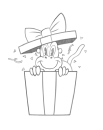Want more? In the premium course you'll get additional lesons, demos, critiques, and more!
To master perspective drawing, you need knowledge, skill, and some basic tools. While you can draw by hand, tools help you do what can't be done manually. Let's explore the essential tools to enhance your drawing skills.
Basic Tools
Pencils
You only need one sharp pencil to learn perspective. An HB pencil works well. Mechanical pencils are recommended because they're inexpensive and reliable. Choose between 0.5 mm lead for finer lines or 0.7 mm for thicker lines. Use what feels comfortable and produces clean lines.
Paper
Two kinds of paper you'll use:
- Bond Paper: Standard printer paper, suitable for most exercises.
- Transparent Paper - When your drawing gets messy, tracing paper lets you start clean. Vellum is best, durable and erasable. If it's too expensive, tape bond paper to a lightbox or window to make it transparent.
Erasers
Two types of erasers:
- Plastic Erasers - Ideal for precision erasing. They have sharp edges and you can cut them to create new edges. They're firm and erase heavy lines well.
- Kneaded Erasers: Soft and shapeable for precision. Great for lightening areas by gently dabbing or rolling.
Drawing Straight Lines
In perspective, we use many straight lines drawn in two ways:
- Freehand: Drawing straight lines freehand is challenging but improves with practice.
- Ruled - Use a ruler or straight edge when you need precision. It's not cheating, it's a tool to aid accuracy.
Understanding Angles
To draw lines at specific angles, understand and measure angles.
Using a Protractor
A protractor helps measure angles from 0 to 360 degrees. Key angles:
- 90 Degrees (Right Angle): Lines are perpendicular.
- Less than 90 Degrees: Acute angles.
- More than 90 Degrees: Obtuse angles.
- Parallel Lines: Lines in the same direction.
Knowing these angles is part of the technical language of drawing.
Drafting Instruments
Two classic tools make drawing common angles easy:
- T-Square: Slides along the edge of your surface to draw consistent horizontal lines.
- Triangles: Used with a T-square to draw vertical lines and angles of 30°, 45°, or 60°. They help create parallel and perpendicular lines efficiently.
Axonometric vs. Linear Perspective
Axonometric Perspective
Axonometric perspective lets you measure along any axis. Used for technical drawings, lines recede at consistent angles without vanishing points. However, it lacks the depth of linear perspective.
Importance of Vanishing Points
In linear perspective, lines aim toward vanishing points, creating depth. Placing vanishing points and drawing to them requires both brain and hand skills. Developing these skills lets you invent any viewpoint and build complex worlds.
Developing Hand and Brain Skills
While tools help, it's important to:
- Practice Freehand Drawing: Improves hand skills.
- Use Tools as Needed: Keep tools simple, using them to solve problems.
- Focus on Learning: We're here to learn linear perspective, the foundation before adding color or rendering.
Want more? In the premium course you'll get additional lesons, demos, critiques, and more!














